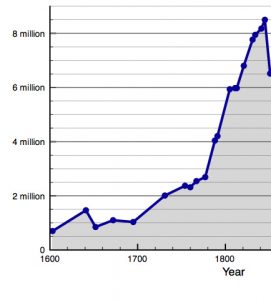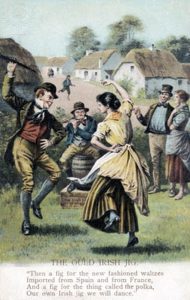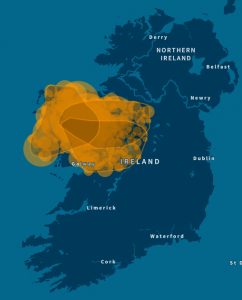 Between 1780 and 1845, the population of Ireland mushroomed from about three million to about eight and a half million. That much is well known and often cited as one of the reasons for the catastrophic devastation of the Great Famine of 1845-49. But such a vast increase must also have had a profound effect on family relationships.
Between 1780 and 1845, the population of Ireland mushroomed from about three million to about eight and a half million. That much is well known and often cited as one of the reasons for the catastrophic devastation of the Great Famine of 1845-49. But such a vast increase must also have had a profound effect on family relationships.

Look at the numbers. The population tripled in size over less than three generations, a veritable explosion. And the growth wasn’t evenly spread, taking place disproportionately among the vast mass of Gaelic Catholic subsistence farmers in the West and the South. Someone born in those areas in the 1820s and 1830s was typically one of a very large family, ten or more, whose parents and grandparents would also typically have come from families the same size. So if your twenty aunts and uncles did their demographic duty, you could easily have two hundred first cousins, all almost probably living within walking distance.
And more distant cousins? Second cousins are all the descendants of a common set of great-grandparents. Taking the same average of ten per generation, you could easily have had more than four thousand of them, again almost all in the same geographic region.
Child mortality and (pretty much unavoidable) cousin intermarriage might reduce some of those numbers, but the point still stands. Immediately before the Famine, some areas of Ireland were populated by extraordinarily dense cousin networks.
Gaelic society had always been tribal, but this was tribalism on steroids. Everyone was literally closely related to everyone around them. No wonder Ancestry’s DNA service is so good at identifying genetic groupings in particular areas of Ireland – the period 1780-1830, the outer limit of its standard autosomal DNA test, is exactly the period when we very obligingly got together and married our cousins like rabbits.

Cousin-density like this also left its mark on a more recent Ireland. Membership of the two main political parties, Fianna Fáil and Fine Gael, often appears to be inheritable, with great masses of relatives voting for (or knifing) each other .
And that great population bulge may be another reason why it’s so hard to get your ancestral line back beyond 1800. Four thousand Jams O’Donnell second cousins?
“The Grenhams hard at it in the 1830s”: I was laughing for five minutes at this!
I’m with Linda!
Why, are you cousins?
My great-grandmother was born Bridget Whelan in 1875. Are we cousins?
Hi John,
Maybe we’re cousins. My grandfather was John Grenham from Cornafulla Co. Roscommon. Just outside Athlone town. His brother and two sisters emigrated to America, sadly never to return to Ireland.
So true. I recently met a woman whose mother was 1 if 17 siblings in her family. This woman has 80 first cousins!!
Very interesting. I appreciate the new insights.
Not sure whether to laugh or cry. Why is it I’m having so much trouble finding my Great Grandfather’s siblings and cousins? Research continues.
This explains why my FTDNA brings up very few Kelly’s, but lots of other names, particularly when it gets back 5-7 generatioal steps.. ?
Since I am only looking for a woman born in Ireland (Catholic) who married a James Barnes (Scotsman)b 1815-1820 is there any way to sort out DNA results for that Irish Ancestor only? I really want to know her name, she died giving birth on the ship in the New York Harbor, to her son James Roderick Barnes 1848-1855 his age differs on the census
Test several cousins who all descend from the ancestor in question and identify which matches they all share in common – many of these matches will have inherited DNA from the ancestor in question. This technique is known as Triangulation and there is a video about it here … https://youtu.be/e9crTBGseKw
Hi Maurice
We could be related I have a Johanna Gleason b. 1809 d. 1910, m. To a Cornelius (Andrew Kelleher) b. 1789 d. 1869 from Coolavokig (Coolea) in Co. Cork. These were my 3 x great grandparents. There son was John (The Mon) Kelleher, from Lissacreasig, his daughter Hannah Kelleher married Dan Hugh Dan Kelleher from Gurranenaguppal, Clondrohid and they had my paternal grandfather Hugh (Goff) Kelleher.
Yes, google “triangulating your dna matches” and “Leeds method”.
Not to mention that each group of ten cousins used the same family first names…
And second, and third, and fourth…..
I feel so left out! Can’t find anyone for my g-g-grandmother Sarah Hourigan, but keep on digging?
Ran into many common first names and smsll group of Presbyterian families in walking distance. So interesting.
Hi John,
Three of my grandparents and six of my great grandparents were born in Ireland.
I’m 70 years old now and still finding 1st cousins(deceased) 2nd cousins(usually deceased)
and more and more living 3rd cousins in Ireland, England and the US.
Well what more can i say than ….”hello” to all my cousins I haven’t yet found as yet…wherever you are!!!!!
There is a huge cluster of DNA matches from O’Callaghans Mills in Clare. We are trying to unravel it all but it is tricky going with surnames McMahon, McNamara and McInerney.
A very timely article for us, reminding us why we are having a hard time figuring it out!
Hi Patricia.
Have you found any Dwyer names in the O’Callagan’s Mills area?
Good Luck.
I’ve been searching for the O’Callaghan Mills elsewhere!! Now I’ll have to find all those O’Callaghan cousins in Clare! Thanks for the heads up
AND they all named their girls Mary or Margaret or Mary Margaret or Margaret Mary; sometimes in the same family. And with the lovely patronymic naming system, first cousins could have similar names across 8 children. Tearing my hair out.
I am researching Michael Kirby married to Bridget Stokes, born about 1830s. married about 1850s, immigrated to the United States about 1870.
If anyone can give suggestions on how to find James Carroll married to Mary Kearns, born about 1840s, married about 1860s, immigrated to the United States about 1865.
I would greatly appreciate any help with this.
Where was Michael Kirby from?
Thanks for all the help with this. I guess I am on my on.
Good points, John, and the map is very interest. But what exactly do you mean when you say “Gaelic society had always been tribal”? Cheers!
Please TAKE ME OFF YOUR EMAIL LIST…
Please remove me from your email list
The advent of the DNA tests (Ancestry, etc) has gone a long way to identify and clarify relationships as well as finding long lost cousins. But I notice that all the folks taking the tests are in the states. I guess the interest is not there in Ireland. Would be nice if someone could convince them to take the test!
That is what we in ISOGG are trying to do by running the Genetic Genealogy Ireland conference each year in the RDS, Dublin … and putting videos of the presentations up on YouTube as a service to the community, an educational resource, and an encouragement to test … https://www.youtube.com/channel/UCHnW2NAfPIA2KUipZ_PlUlw/videos?view_as=subscriber
I have 4 lines of Kellehers in my family, no wonder I am confused. Trying to find siblings of my direct paternal Kellehers. These all resides around the parish of Clondrohid, which has probably more Kellehers than anywhere else.
John doesn’t mention in the article that the population in Ireland more than tripled even while a mass migration to America was underway. For example, my 4GG, Robert Ireland, born in Belfast in 1765, had five sons and one daughter. He, plus five of his six children, had all left Ireland by 1829.